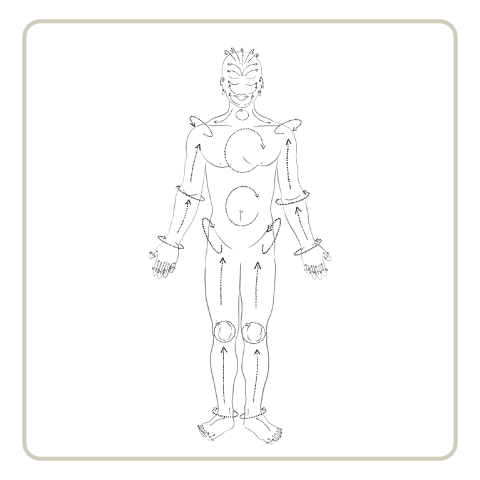
5:20 min read
Massage, the path to health
Origins
Practice
Benefits
Abhyanga is not just about obtaining a more supple and soft skin. Its benefits range from helping regulate digestion by stimulating the internal organs, to decreasing the amount of cortisol (stress hormone) released by the body. When practiced correctly and regularly, Abhyanga carries tons of other benefits for many systems in your body:
- Nervous system. Not only does it help unwind after a long day, but the recurring release of oxytocin (the hormone associated with love) that occurs when massaging the several layers of tissue helps soothe the nervous system and better your mood.
- Vascular system. The methodical massaging of the body induces a healthier and stronger blood flow.
- Musculoskeletal system. It can alleviate mild injuries and pains from strenuous muscular work. It improves muscle tone in the arms and legs.
- Moreover, it can help the lubrication of the joints as well as their mobility.
- Lymphatic system. Done correctly, Abhyanga helps speed up the elimination of toxins by improving the flow of lymph.
- Integumentary system. The scalp becomes healthier as its own sebum is protected, leading to healthier and better-looking hair. The skin finds nourishment and youthfulness, and it also improves its elasticity and becomes more resilient to dryness and environmental harshness.

“Ayurveda and Traditional Chinese Medicine have long regarded the skin, our largest organ, to be a vital part of our immune system. Modern science informs us that these millennia-old wisdoms were correct. We have billions of beneficial microbes on our skin. In the symbiotic human-microbe relationship, sebum (the oil our skin naturally produces) and applied oils feed the microbes and the microbes in turn boost our immune response and help protect the skin from non-beneficial microbes. When we keep our skin well-moisturized with natural, organic oils, we are keeping our microbial allies happy and healthy, and they in turn help to keep us healthy as well.” (Klinzing-Le, 2020)
Before you get started
Oils for Vata
Oils for Pitta
Oils for Kapha
Before you begin your Abhyanga, make sure you have all the necessary supplies, so you don’t have to stop mid-practice nor risk stepping on a slippery surface once you are oiled-up.

Getting Started
- Set up your space. Make sure you are in a warm room with no air currents. Place one towel on the floor so you don’t slip while using your oil. You can do your massage sitting or standing up, depending on what you find more comfortable.
- Warm your oil, if needed. Place your oil container in your water receptacle and leave it in for a few minutes, depending on the temperature you want.
- Remove your clothes and accessories when you are ready to begin; remember to test your oil’s temperature on your wrist first.
- Close your eyes, breathe deeply, and focus on the now. Slowly open your eyes.
- Begin by pouring your oil on the crown of your head. Ayurveda does recommend the massaging of the head and neck in slow, circular motions. Still, you can skip this step if you don’t want to oil your hair and scalp as your daily routine may not always allow it, for it takes a bit longer to wash off (mainly from the hair).
- If you are going to massage your face, do so in circular, upward motions. Don’t forget your ears!
- Move on to your body, always from the extremities to the center, and right to left.
- For the arms and legs, use long strokes. Use circular strokes for the joints. For the abdomen and chest, go with wide clockwise motions.
- Finish off with your feet. Massage them mindfully in a way you find to your liking. You might need a bit of extra pressure in this area. Take your time to figure out what works for you.
Ayurvedic Ancient Wisdom



Advice
- When there is excess Ama (or toxicity) in the body
- If you are suffering from severe gastrointestinal issues
- Right after a meal
- When there is an excess in Kapha
- If you have a fever or the chills
- During pregnancy
- While menstruating
- After having a Basti (Ayurvedic enema) performed
